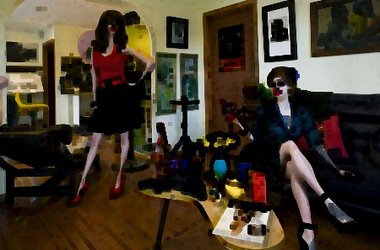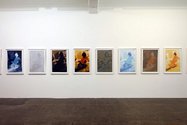John Hurrell – 11 June, 2010
The multi-variation works are of most interest because they feature investigations of image manipulation, where hue, tone, shape edge, and line thickness are altered. The darker photographs within each series work better by virtue not only of their sultry, romantic, or perhaps lascivious mood, but because of the spatial depth they bring to the architectural environs being depicted, an optical penetration that is extremely knowing - considering the theme.
This four work exhibition of colour photography by Patrick Reynolds teases out the notion of a stockings and knickers clad female beauty as Muse - the inspiration for a male heterosexual artist. The show is a exploration of digital processes as an extension of post-impressionist painting (pixilation as clusters of brushmarks). It looks playfully at the idea of a lover (fantasized or real) driving the creative energies of the artist: maybe as sublimation of sexual passion; maybe not sublimated but propelled by overt horniness; perhaps just as deep loyal affection (or metaphorical priapism only).
Two works on the innermost wall are black and white variations of the same image (Dreamhome), one other (Muse Variations) takes up the main wall with twelve parts (all variations also of the same image) and one other photograph by the window (Esprit d’escalier) is solo.
The multi-variation works are of most interest because they feature investigations of image manipulation where hue, tone, shape edge, and line thickness are altered. The darker photographs within each series work better by virtue not only of their sultry, romantic, or perhaps lascivious mood, but because of the spatial depth they bring to the architectural environs being depicted, an optical penetration that is extremely knowing - considering the theme. And of course these visually lush images are rich in connections to the history of nineteenth century painting.
It is hard to say where formal properties finish and symbolic tropes begin in this mildly provocative (some might say - puerile and laddish) show, for the other paler images loaded up with tinted ‘negative’ forms have a sort of flickering space that blocks the eye, limiting it to perusing a shallow hazy tray. These are a bit forgettable. They lack drama and seem like exercises for exercises’ sake. They seem anaemic.
In a nutshell the lustier images are accompanied by a formal dynamic that buys into desire as spatial metaphor. It is not an especially clever show but it is interesting, particularly if you like speculating about the sorts of relationship male painters/photographers have with their models. If you don’t, you’ll probably find it a bit cliched, and hate it.
John Hurrell








 Two Rooms presents a program of residencies and projects
Two Rooms presents a program of residencies and projects Advertising in this column
Advertising in this column



This Discussion has 0 comments.
Comment
Participate
Register to Participate.
Sign in
Sign in to an existing account.